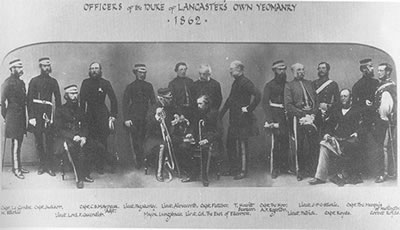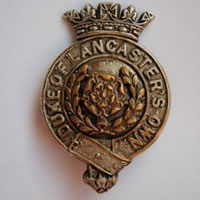
Officers of the Duke of Lancaster's Own Yeomanry 1862.
Charles Patrick is fifth from the right.
(L-R: Capt N Starkie, Capt Jackson, Lieut Lord F. Cavendish, Capt C E Molyneux, adjt, Lieut Fazakerly, Major Langstraw, Lieut Ainsworth, Lieut Col the Earl of Ellesmere (seated), Capt Fletcher, T Hewitt, surgeon, Capt the Hon A F Edgerton, Lieut Patrick, Lieut J P C Starkie, Capt Royds, Capt the Marquis of Huntingdon, Cornet Royds)
The Duke of Lancaster's Own Yeomanry was formed in 1827 as the Lancashire Corps of Yeomanry Cavalry by the merger of the three volunteer mounted units in Lancashire: the Bolton Yeomanry, the Furness Yeomanry and the Wigan Light Horse. It was renamed the Duke of Lancaster's Own Yeomanry in 1834 by William IV. Volunteers had to provide their own horse and were provided with saddlery and uniform. This is in contrast to the infantry volunteers in Rossendale who had to provide their uniform, arms and accoutrements with payment for the same at 6d/week.
By Patrick's time, training comprised one or two evenings per week in the local troop (in Patrick's case, Rochdale) and a two week residential camp, usually in Lancaster. As part of this the unit was inspected by a regular cavalry officer who reported the unit as 'efficient' or not. A typical newspaper report of camp is linked on the left.
Before the founding of the police force the Yeomanry were occasionally called upon for riot control, most notably at the Luddite riots and Peterloo. By Patrick's time their duties were largely ceremonial, although they remained susceptible for call up for regular duties.
(Hayhurst, Volunteer, and Read, Yeomanry)
By Patrick's time, training comprised one or two evenings per week in the local troop (in Patrick's case, Rochdale) and a two week residential camp, usually in Lancaster. As part of this the unit was inspected by a regular cavalry officer who reported the unit as 'efficient' or not. A typical newspaper report of camp is linked on the left.
Before the founding of the police force the Yeomanry were occasionally called upon for riot control, most notably at the Luddite riots and Peterloo. By Patrick's time their duties were largely ceremonial, although they remained susceptible for call up for regular duties.
(Hayhurst, Volunteer, and Read, Yeomanry)
Ceremonial duties included:
Oct 1857 Visit by Queen Victoria and the Prince Consort to Worsley
July 1869 Visit by Queen Victoria and the Prince Consort to Manchester
(Read, The Duke of Lancaster's Own Yeomanry, Lancashire County Books 1992.
Oct 1857 Visit by Queen Victoria and the Prince Consort to Worsley
July 1869 Visit by Queen Victoria and the Prince Consort to Manchester
(Read, The Duke of Lancaster's Own Yeomanry, Lancashire County Books 1992.





